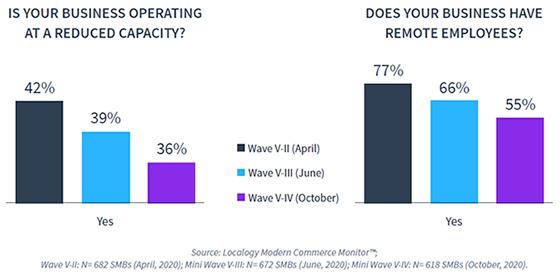
How are businesses faring during COVID-19? There has
been much discussion about building platforms and using technology, but smaller companies -- those with less than 500 employees in retail, home services, personal services, automation, and
professional services -- continue to struggle.
The most recent Localogy State of SMB-October 2020 report is the fourth released this year that focuses on small business. About 1,009
interviews were done via an online panel between September 21 and October 7, 2020 for the latest report. The last of four reports was released in June. The data reveals that in April, about one-third
of businesses in the U.S. were closed.
Nearly 60% of the open businesses operated at reduced capacity, and half of the small businesses had to furlough or lay off employees. At the time this
study took place, 88% of small businesses were open, but in places like California, most restaurants across the state are now restricted to patio dining or takeout only.
advertisement
advertisement
Some 36% of businesses
are still operating at reduced capacity, and 33% still have laid off or have furloughed workers. In addition, 55% of businesses still have employees working remotely.
One-third of business
owners have invested significantly in technology, according to the data. Top areas are focused around the productivity of remote workers, but business owners have expanded to other areas. Many have
adopted mobile work environments.
Highlights from the report also point to the fact that 55% of businesses still have employees working remotely.
Sustaining a remote workforce means a
technology investment. The report found a 61% increase in video conferencing; a 63% increase in virtual office software; and a 57% increase in productivity, project management, and document management
software.
These findings, among others, illustrate the impact of dramatic changes in the way small businesses operate. While operations have seen the greatest shift toward tech-driven
transformation, the data shows a 43% increase in SaaS investment related to supply-chain services and a 21% increase in customer relationship management software.